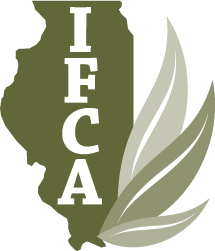Post Dicamba June 20 Cutoff & 85 Degree Temperature Reminder
With post application of dicamba over the top on soybeans right around the corner, IFCA would like to remind everyone of the Illinois Department of Agriculture restrictions for Xtendimax, Engenia, and Tavium.
For clarification, the 85-degree temperature restriction means that if the weather.gov website has a forecasted high of 86 or more for the zip code of the field to be sprayed, then the entire day is a Do Not Spray Day. In addition to looking at the graphic image of the forecasted high, you can also select the "detailed forecast." The detailed forecast in many cases may indicate "high near 86" and IDA has clarified to IFCA that "high near 86" also means 86 degrees, and thus is a Do Not Spray Day.
IFCA encourages our members to keep detailed records of dicamba application; we have prepared a guidance document with the help of IDA to provide details on how to document temperature, wind speed, wind direction and the required downwind and endangered species counties buffers. The IFCA recordkeeping guidance document is available here. You can also find all three-application recording-keeping forms here .
IFCA worked with Illinois Department of Agriculture to form a 2021 dicamba FAQ for the upcoming spray season. The document is filled with helpful information. Please click here to review the FAQ.
The Illinois Department of Agriculture re-affirmed to IFCA today that the June 20 cut-off date for the application of dicamba remains in place. We realize the pressure that ag retailers are under to apply dicamba ahead of the June 20 cut-off. Violation of either the cut-off date, temperature restriction or lack of recordkeeping will likely be considered a willful violation of the Illinois Pesticide Act. Please visit with your customers on these label requirements so that they will understand what is required in Illinois. If you have questions please contact KJ Johnson at (217) 369-1669.
- Prohibiting over the top application of dicamba on soybeans after June 20.
- Prohibiting over the top application on dicamba soybeans if the air temperature at the field at the time of application is over 85 degrees, or if the National Weather Service's forecasted high temperature for the nearest locations for the day of application exceeds 85 degrees. Refer to the Local National Weather Service forecasts at http://www.weather.gov.
- Requiring an approved pH-buffering agent (also called a Volatility Reduction Agent or VRA) be tank mixed with over the top dicamba products prior to all applications to control volatility.
- Requiring a downwind buffer of 240 feet to protect sensitive areas and 310 feet in areas where listed species are located. (IFCA Note: To clarify, Illinois has 18 endangered species counties, refer to the following map. In these counties the downwind buffer to protect sensitive areas will be 310 feet and 57 feet on all other sides of the field. All labels will still have a "do not spray" if sensitive crops are downwind.)
- The ability to use hooded sprayers to reduce the downwind buffer size. A buffer of 110 feet can be used in counties not deemed to have endangered species, and a buffer of 240 feet within counties that are designated as having endangered species.
- Before applying a pesticide containing dicamba on soybeans, the applicator shall consult the FieldWatch sensitive crop registry https://www.fieldwatch.com and comply with all associated label and recordkeeping requirements.
- Application on soybeans with a pesticide containing dicamba shall not be made if the wind is blowing toward:
- Any Illinois Nature Preserves Commission site that is adjacent to the field of application. Map of Illinois Nature Preserves Commission.
- An adjacent residential area.
For clarification, the 85-degree temperature restriction means that if the weather.gov website has a forecasted high of 86 or more for the zip code of the field to be sprayed, then the entire day is a Do Not Spray Day. In addition to looking at the graphic image of the forecasted high, you can also select the "detailed forecast." The detailed forecast in many cases may indicate "high near 86" and IDA has clarified to IFCA that "high near 86" also means 86 degrees, and thus is a Do Not Spray Day.
IFCA encourages our members to keep detailed records of dicamba application; we have prepared a guidance document with the help of IDA to provide details on how to document temperature, wind speed, wind direction and the required downwind and endangered species counties buffers. The IFCA recordkeeping guidance document is available here. You can also find all three-application recording-keeping forms here .
IFCA worked with Illinois Department of Agriculture to form a 2021 dicamba FAQ for the upcoming spray season. The document is filled with helpful information. Please click here to review the FAQ.
The Illinois Department of Agriculture re-affirmed to IFCA today that the June 20 cut-off date for the application of dicamba remains in place. We realize the pressure that ag retailers are under to apply dicamba ahead of the June 20 cut-off. Violation of either the cut-off date, temperature restriction or lack of recordkeeping will likely be considered a willful violation of the Illinois Pesticide Act. Please visit with your customers on these label requirements so that they will understand what is required in Illinois. If you have questions please contact KJ Johnson at (217) 369-1669.
